Marigold Ballroom
1336 Nicollet Ave.
Minneapolis
The Marigold Ballroom was located at 1336 Nicollet Ave. in Minneapolis. (1330-1342 Nicollet according to City permit cards.) Its boundaries were Grant Street W on the South, Nicollet on the East, LaSalle on the West, and 13th Street on the North. 13th Street has vanished in its current configuration. One parcel is now identified separately as 14 Grant Street, but the permit cards lump it all together as 1330-1342 Nicollet.
It also appears that the building did not go all the way to Grant Street, at least on the Nicollet side. There is a strange looking building there in the 1936 photo below, and a burger joint in the 1950 photo. This may be 22 Grant Street, which is still a separate parcel.
It appears that the first permit was taken out on November 1, 1911. An article says that the building originally housed the Laybourne Auto Company and several retail stores. I couldn’t find the auto dealer, but there was a bakery in 1917, which was advertised for sale in October 1924.
More ads and information to come.
MARIGOLD GARDEN/GARDENS
The ballroom opened on November 24, 1923, as the Marigold Garden, described in ads as located at Grant at Nicollet. The name morphed over time, sometimes known as the Marigold Gardens Ballroom, before settling on Marigold Ballroom
In September 1924 the ballroom was sold, and the managers went to court to restrain the new owners from interfering in the operation of the facility.
Permit cards show work altering a store to a Mortuary in the building, October 10, 1924. The cost was a high $1,000.
On November 29, 1924, the Yellow Cab Co. hosted 500 Minneapolis orphans to a meal at the Marigold, a show of Vaudeville, a parade and tour of the city. 500 orphans.
By December 1924 the name appears to have settled on Marigold Ballroom (albeit spelled Ball Room), and identified no longer at Nicollet and Grant but at 13th and Nicollet.
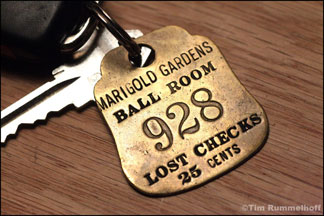
On February 22, 1925, the first broadcast of radio station WAMD emanated from the Marigold Garden. The station broadcast all music, and its call letters stood for “Where All Minneapolis Dances.” Broadcasts were initially on Sundays from 2:15 to 5, and continued until the end of July 1925 when the station moved to the Radisson Hotel. WAMD became KSTP in 1928.
Permits indicate that there was a fire on October 28, 1925, but all that was in the paper was an ad to come and see Charleston dancers.
Then, after June 1926, a pause.
THE NEW MARIGOLD BALLROOM
The New Marigold Ballroom opened on September 6, 1926, with a splash – and a rare full-page ad in the Minneapolis Daily Star on September 4. An article in the same paper explained how the ballroom started out small, and then acquired one business after another in the building to expand to meet demand. In September 1926, the ballroom’s footprint was a “half block deep, quarter block wide” at Nicollet and Grant. It was at this time that another $100,000 was put into the property to expand it further, with 32,000 square feet. A ladies lounge and special cosmetics room were added, and the men’s smoking room and lounge were moved to the basement so they could be expanded. Employees were to be dressed in evening dress. There were two orchestras. The checkroom accommodated 3,600 coats. Girls had to be 18 to enter, boys had to be 21. (Girls mature so much faster than boys…)
The great Fletcher Henderson brought his famous swing band to the Marigold Ballroom on April 20, 1937. The show was called a “white dance” by the Minneapolis Spokesman. The night before, Henderson performed at the Coliseum Ballroom in St. Paul, “the first time in 12 years that the colored people have had an opportunity to dance to the strains of a nationally known orchestra.” The Spokesman reported that almost 15,000 people attended the dance, the largest dance crowd assembled in the Twin Cities in 20 years.
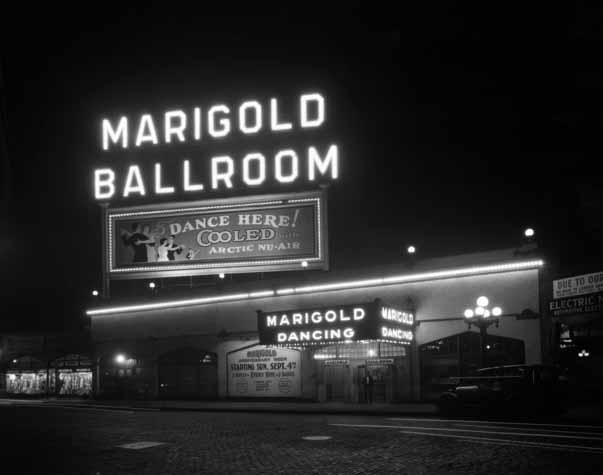
The New Orleans’ Rhythm Kings appeared in the late 1920s, as well as local groups like Eddie Corlew’s and Steamboat Smith’s bands. The Marigold Entertainers were featured until about 1929.
THE NEW NEW MARIGOLD
Further refinements and enlargements were made in 1929, with a grand opening on August 31.
The ballroom’s motto was, “Never Grow Old Dancing at the Marigold.” There was a sign to that effect in the ballroom, and it showed up on ads in 1959.
1950 REHAB
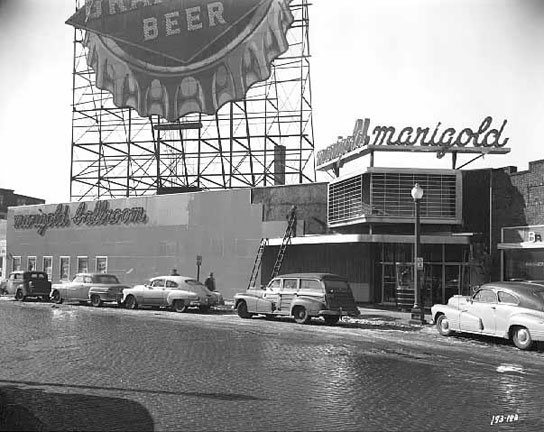
Permit records indicated something about a bowling alley in December 1940, but maybe it was just sharing the building with the ballroom.
On March 5, 1941, an electrical fire that started in the ballroom’s control room in the basement sent sparks flying up the wires and out to the electrical poles, shutting off the electricity for the ballroom and the neighborhood. The Tribune reported minimal damage.
Elmer A. Larson became the manager of the ballroom, and bought it in 1972.
A Gala Shrine Frolic with Preston Love and His Orchestra (“The Happy Boy With the Horn”), appeared at the Marigold Ballroom on January 30, 1956.
On May 24, 1956, Woody Herman’s Third Herd played at the venue to celebrate its 40th anniversary; it was the first name band to play there since Paul Whiteman in 1930.
Country singer Hank Thompson appeared at the Marigold Ballroom on August 13, 1956.
Duke Ellington and His Famous Orchestra appeared at the Marigold Ballroom on November 6, 1957.
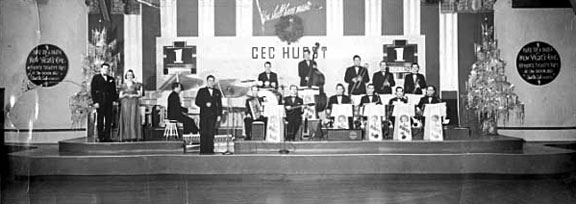
In March 1958 WLOL hosted the Royal Crown Cola Bandstand at the Marigold Ballroom, with DJs Dan Anderson and Don Dahl, Sunday afternoons from 2 to 5pm. Admission was 50 cents and open to teens age 16 and over. “It’s the swinginest!”
1962 ad: “The New Marigold Ballroom – Minneapolis’s Smartest and Largest.”
A national dance contest was sponsored by the American Federation of Musicans to find the best new dance band of the year. On March 16, 1959, the local contest, sponsored by the Minneapolis Musicians’ Association, took place at the Marigold Ballroom. Each band would play four numbers. The winner would compete in a regional contest in Des Moines; a semi-final in Chicago; and the final in New York. The winner was promised a recording contract with Decca records, a national TV appearance, all new instruments, and weeks of bookings at ballrooms all over the country. Entry was free, bands could not have more than 15 pieces, and the music had to be “modern dance music.” “(Other contests for rock ‘n’ roll, hillbilly, western, old time, Dixieland, or be-bop may be held later.)” Bands would be judged on showmanship (appearance and presence); tone quality; rhythm; and musical arrangements.
B.B. King appeared at a Mother’s Day Matinee Dance at the Marigold Ballroom on May 10, 1959, presented by the Horsemen.
Willie Mabon appeared at the Marigold Ballroom for a Sunday Matinee dance on June 14, 1959. It was billed as a “Wash and Wear Affair,” promoted by The Horsemen.
Bobby Bland appeared at the Marigold Ballroom on July 26, 1959.
The Shrine Gala Day at the Marigold Ballroom was on September 25, 1959, 9 pm “til unconscious.” Music was provided by Hank Hazlett and His Band.
Roy Milton’s band, featuring Mickey Champion, blues and ballad singer, appeared at the Marigold on March 12, 1961. They had been appearing at the Key Club since January 19, 1961.
Brook Benton, with the Milt Buckner Orchestra, appeared on April 14, 1961.
Joe Williams, formerly with Count Basie, appeared at the Marigold Ballroom on June 16, 1961.
1962
On January 5, 1962, dance instructor David La Vay held an all-city “Twist” Night at the Marigold Ballroom featuring that perennial rock ‘n’ roll group, Mike Waggoner and the Bops.
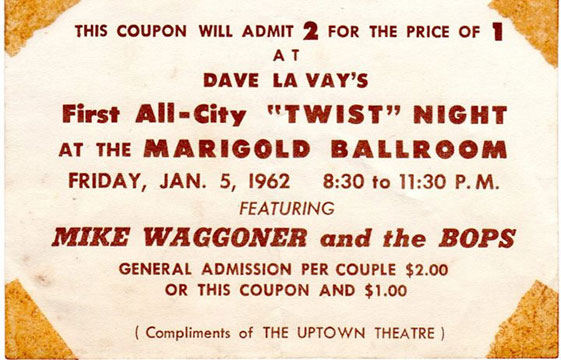
Twist to Johnny and the Galaxies on February 2, 1962. This may not have been a local band.
The Corvets provided the music for a “Rock-Roll N’ Twist Hop” on February 23, 1962.
Bill Diehl appeared with Mike Waggoner and the Bops on March 2, 1962.
Bill Diehl was back on March 23, 1962, hosting a Battle of the Bands. Who won? The Diablos or the Corvets? Both were very early, hardworking bands.
DJ Hal Murray hosted the Diablos at a teen dance on April 6, 1962.
Dickey Lee played the Marigold Ballroom on December 26, 1962. Bill Diehl was there as emcee.
1963
Mike Waggoner and the Bops played for the teens on January 2, 1963.
March 22, 1963, promised an all-star Teen Hop with Mike Waggoner and the Bops and the Dorados.
In August 1963 the ballroom was air conditioned. Many of the dances featured old time bands and/or specified different age limitations for different nights. Some were over 21, some over 25, some over 28. Dances were NEVER for people over 30, though, because women didn’t want to admit they were of that certain age!
1964
Bill Diehl appeared with Mike Waggoner and the Bops on March 20, 1964.
The Marigold Ballroom was the site of many acts that R&B station KUXL brought in, hosted by DJ Preacher Paul. Bobby “Blue” Bland might have been the first KUXL show, appearing on July 22, 1964.
Bo Diddley got the Marigold going on August 19, 1964. It was the same night Count Basie was at the Prom, and a conflict was feared, but Will Jones reported that Mr. Diddley drew 1,500 “sweating youngsters, ” and the Count drew 1,350 “oldsters.” (Minneapolis Tribune, August 21, 1964)
The Tams made an appearance on August 23, 1964.
Bobby Freeman, who did “Let’s Do the Swim,” came to the Marigold on September 27, 1964.
On November 6, 1964, national group the Hondells went head-to-head with local heroes the Gestures from Mankato.
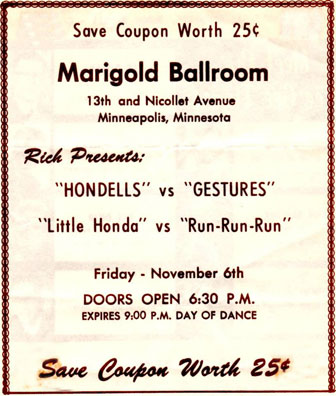
1965
An epic blizzard prevented Bobby “Blue” Bland from making a KUXL-sponsored dance in March 1965, but a local musician was found to substitute, admission price lowered, and the event still drew 2,600 people.
The Impressions made an appearance at the Marigold on April 11, 1965.
THE MIDWEST AU-GO-GO
Midwest Au-Go-Go was held on June 4, 1965, at the Marigold. On the bill were the three biggest local bands in town:
- Gregory Dee and the Avanties
- The “Wild” Accents
- The “Stompin’” Underbeats
Now the flier doesn’t give the year of this blowout. You can cheat and look to see what year April 4 falls on a Friday, but that’s really not necessary, since 1965 was the year of the “Au-Go-Go.” Were you a “Hip Swingin’ Au-Go-Go Dancer? Sigh.
I apologize that I do not know the origin of this flyer – I probably grabbed if off of Facebook. If it is yours, please contact me so I can give you credit.
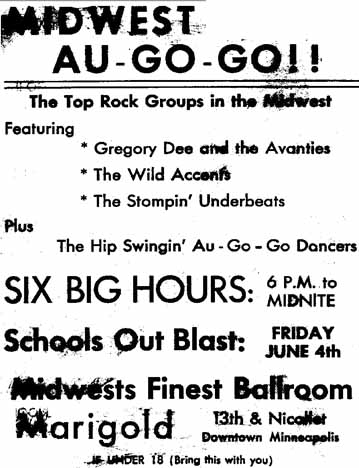
UPBEAT!
“Hey! It’s Upbeat! Dance every Friday nite at the Marigold Ballroom to top local and national groups.” Former disk jockey Dino Day (aka George Murphy) taped the show here to be shown on Sundays on Channel 9. The show premiered on August 1, 1965. See TV Shows.
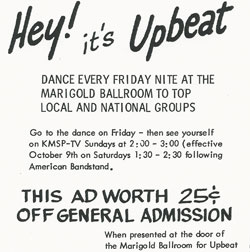
KUXL sponsored an appearance by Ike and Tina Turner at the Marigold on August 1, 1965. The appearance brought 5,000 fans.
The Trashmen came to the Marigold on August 20, 1965.
On August 23, 1965, a fracas broke out involving 400-500 young people throwing eggs and rocks at cars, about a block from the Ballroom. Except that police reported that the incident only involved “several” youths. (And where would they get eggs?) One 20-year-old was arrested. Half an hour later, police were called to break up the crowd of 200 who had gathered outside the Ballroom when an “unidentified youth discharged a fountain pen tear gas gun. Police said they did not use tear gas to break up the crowd.” (Minneapolis Tribune, August 25, 1965)
BB King performed at the Marigold on September 12, 1965. The announcement was in small print in an ad for another show.
1966
Jackie Wilson was scheduled to perform at the Marigold on January 14, 1966, but didn’t arrive until midnight, causing a “near-riot” at the ballroom when the 1,600 people in the audience “became annoyed.” Police were called and the City Council discussed the matter. (Minneapolis Tribune, January 27, 1966)
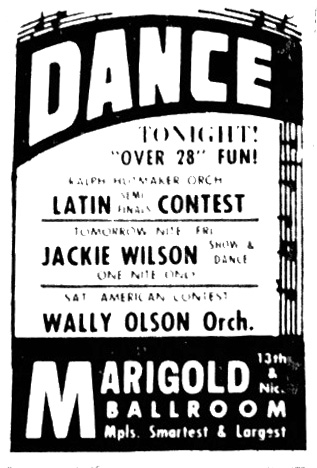
Rufus Thomas appeared with local group the Amazers on June 24, 1966.
Pam Schmitz found this fabulous poster, advertising a six-hour marathon of the Cities’ favorite bands, playing at the Marigold Ballroom on September 9, 1966.
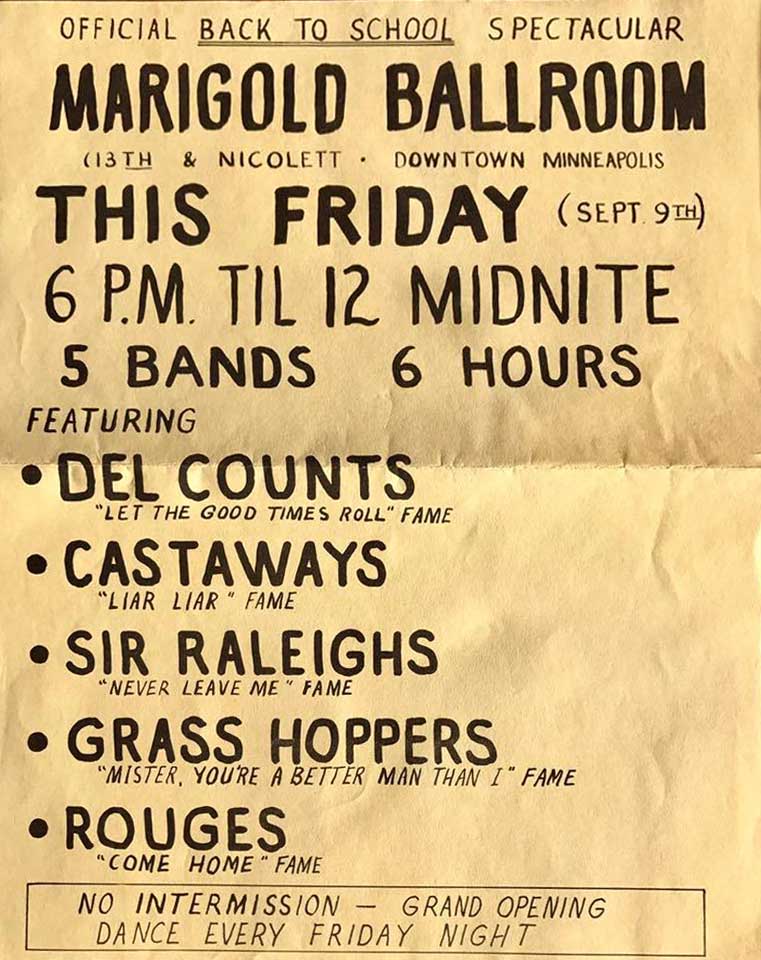
The Temptations came to the Marigold on October 16, 1966, and police had to be called when 800 to 1,000 people on the sidewalk got impatient waiting to buy tickets at the one ticket booth. Police shut down Nicollet Ave. and were heckled by the crowd. The glass in the ticket booth was broken in two places, but Ballroom manager Elmer Larson insisted that there was no danger of the crowd getting out of hand and that the booth broke because it was “poorly constructed.” One person was sought for breach of the peace. (Minneapolis Star, October 18, 1966) Interestingly, the name of the act was never mentioned in the news reports.
1967
KUXL hosted the Impressions at the Marigold Ballroom on January 22, 1967. Also appearing were the Amazers.
The Del Counts held a record release dance on March 17, 1967.
The Byrds performed at the Marigold Ballroom (and also in Mankato), perhaps on November 10, 1967.
Harvey Scales and the Seven Sounds, in town for a gig at King Solomon’s Mines, performed on October 27, 1967, at the Marigold.
Other acts included: (This list may have come from the Insider.)
- Solomon Burke
- Chuck Jackson
- Fats Domino
- Little Milton
- Junior Walker and the All-Stars
- The Four Tops
1973
Bonnie Raitt was the first of a series of performers booked into the Marigold Ballroom by Owen Husney of Owen Productions. She did two shows on October 14, 1973, opened by Keith Follese and Willie and the Bumblebees. The otherwise old time/polka/big band venue began a policy of hosting rock acts.
1974
January 18, 1974: Melissa Manchester, Danny O’Keefe, and introducing (Jim) Muske and (Nick) Raths. Show promoted by Owen Husney.
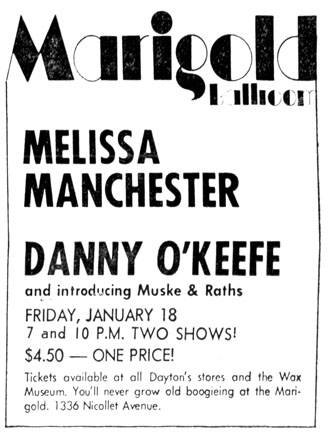
April 17, 1974: Foghat and Montrose. Show promoted by Owen Husney.
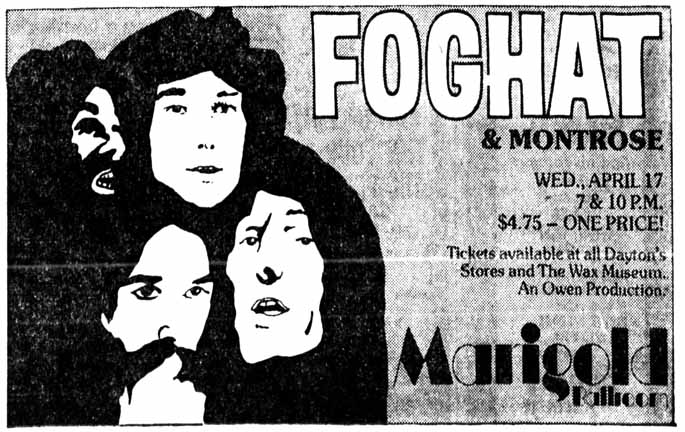
July 14, 1974: David Bromberg and Wendy Waldman (2 shows). Show promoted by Owen Husney.
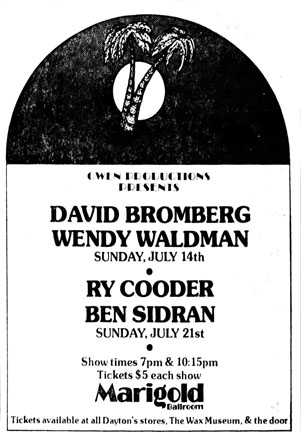
July 21, 1974: Ry Cooder and Ben Sidran (2 shows). Louis Kemp brought his old friend Bob Dylan in to see this show by pretending to be roadies. There were no incidents during the show, but word began to spread that he was there after the show and they had to get out quick. (Minneapolis Tribune, November 10, 1974)
Owen Husney remembers:
One of my crew told me that someone was at the door with Bob Dylan. Skeptical, I shouted at the dude, “You show me Bob Dylan and I’ll not only let you in but will buy you anything you want!” 5 secs later Dylan walks up behind the guy. Bob hung out after the show talking to Ry while the owner’s wife was sweeping up. Oblivious, she said, “You boys, show’s over! Get the hell out!” Bob left like a scolded child before I could get to her.
August 25, 1974: Dr. John. This show had to be cancelled due to a scheduling conflict.
October 13, 1974: Billy Joel, Brewer & Shipley. Show promoted by Owen Husney.
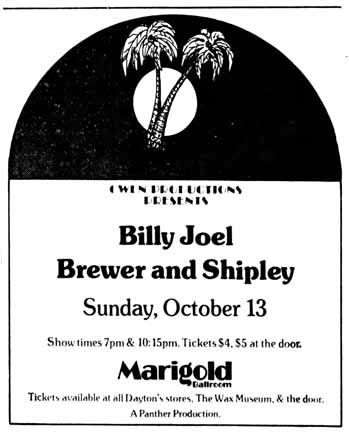
November 3, 1974: Heartsfield, Muske and Raths. Show promoted by Owen Husney. Originally scheduled for two shows, it turned out that the band was also booked at the U during the same week, hurting attendance at both venues. The U opened its show free to students, while Husney cut back to one show.
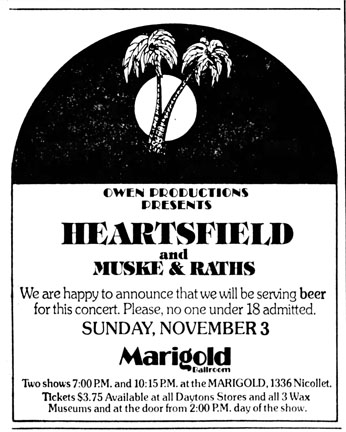
CLOSING OF THE MARIGOLD
The Marigold closed on May 24, 1975; the Tribune reported that the reason was “urban renewal.” Long-timers figured they’d have to go to the Medina to dance, but it was less civilized there – they don’t dance clockwise and people get bumped into. A Cupid Club of about 300 couples who met there and married got together for the last time.
The Larsons wasted no time holding an auction of the ballroom’s precious accoutrements. A wrecking permit was issued on October 7, 1975.
1300 Nicollet Mall was built in 1979 and is now the Hyatt Regency Hotel. The section sometimes known as 14 Grant Street is the parking lot.
THE ROOFTOP SIGN
It was in 1926 that the scaffolding for the huge sign was placed on the building. The top of it was 50 feet above the roof and it was 68 feet long.
The first sign on the scaffold read MARIGOLD BALLROOM in illuminated letters that were ten feet high.
Photos give us a hint of when the sign was changed. In pictures taken during the rehab process in 1950, we see that the iconic Grain Belt Beer sign was up. The latest date we can document is April 13, 1950.
That Grain Belt sign was moved to a small plot of land at 2 West Island Ave. on Nicollet Island in 1950, where it stands today. According to an MPR story from 2009 (quoted on Facebook), “The Eastman family, descendants of some of the first settlers of the island and the land’s first developers, owned this small parcel, which presented this prime location for advertising. According to a Minnesota Public Radio story in 2009, the original terms of the lease were $1,000 per month, plus 50 cents per barrel of beer.”
The building permit for 4 West Island Ave. is dated June 21, 1950, for a 40 x 60 x 100 ft. billboard, erected at a cost of $5,000.
Fun fact from Old Minneapolis: a similar Grain Belt sign was on N. Washington Avenue at 1st Avenue N. in the 1940s, the same general time that the Marigold sign went up.
By May 1953 the Marigold’s Grain Belt sign had been replaced with a City Club sign. A later photo shows a billboard for Calvert Reserve.


